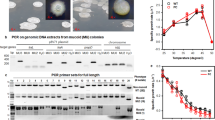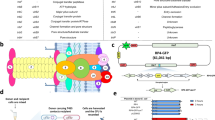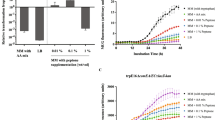Abstract
CONJUGAL opines secreted by crown gall tumours induce strains of Agrobacterium tumefaciens that are donors of Ti plasmids to produce a diffusible conjugation factor1. This enhances the conjugal transfer efficiency of the Ti plasmid in other strains of A. tumefaciens. This factor behaves as a secondary messenger, transmitting the environmental information to tra genes. Here we report the use of spectrometry to show that this factor is identical to synthetic N-(β-oxo-octan-l-oyl)-L-homoserine lactone and confirm that the synthetic compound is biologically active. N-(Hexan-l-oyl)-L-homoserine lactone has also been detected. A closely related molecule, N-(β-oxo-hexan-l-oyl)-L-homoserine lactone, autoinduces bioluminescence in the distantly related bacterium, Vibriofischeri2. N-Acyl-homoserine lactones thus seem to be conserved molecules in which the length and nature of the lipophilic acyl chain determines the biological function to be regulated. Mutants that do not produce the factor fail to conjugate unless supplied with it in the induction medium (our unpublished data). These data indicate that the conjugation factor is an autoinducer and a key signal molecule in the conjugation system of A. tumefaciens. It is, to our knowledge, the first example of a second messenger molecule in a bacterial conjugation system.
This is a preview of subscription content, access via your institution
Access options
Subscribe to this journal
Receive 51 print issues and online access
$199.00 per year
only $3.90 per issue
Buy this article
- Purchase on Springer Link
- Instant access to full article PDF
Prices may be subject to local taxes which are calculated during checkout
Similar content being viewed by others
References
Zhang, L. & Kerr, A. J. Bact. 173, 1867–1872 (1991).
Eberhard, A. et al. Biochemistry 20, 2444–2449 (1981).
Piper, K. R., Beck von Bodman, S. & Farrand, S. K. Nature 362, 448–450 (1993).
Eberhard, A., Widrig, C. A., McBath, P. & Schineller, J. B. Arch. Microbiol. 146, 35–40 (1986).
Bainton, N. J. et al. Gene 116, 87–91 (1992).
Cao, J.-G. & Meighen, E. A. J. biol. Chem. 264, 21670–21676 (1989).
Petit, A. & Tempė, J. Molec. gen. Genet. 167, 147–155 (1978).
Still, W. C., Kahn, M. & Mitra, A. J. org. Chem. 43, 2923–2925 (1978).
Miller, J. H. Experiments in Molecular Genetics 352–359 (Cold Spring Harbor Laboratory Press, New York, 1972).
Oikawa, Y., Sugano, K. & Yonemitsu, O. J. org. Chem. 43, 2087–2088 (1978).
Stachel, S. E., An, G., Flores, C. & Nester, E. W. EMB0 J. 4, 891–898 (1985).
Author information
Authors and Affiliations
Rights and permissions
About this article
Cite this article
Zhang, L., Murphy, P., Kerr, A. et al. Agrobacterium conjugation and gene regulation by N-acyl-L-homoserine lactones. Nature 362, 446–448 (1993). https://doi.org/10.1038/362446a0
Received:
Accepted:
Issue Date:
DOI: https://doi.org/10.1038/362446a0
This article is cited by
-
Quorum quenching by a type IVA secretion system effector
The ISME Journal (2023)
-
Comparative genome analysis of Bacillus thuringiensis strain HD521 and HS18-1
Scientific Reports (2021)
-
A widespread response of Gram-negative bacterial acyl-homoserine lactone receptors to Gram-positive Streptomyces γ-butyrolactone signaling molecules
Science China Life Sciences (2021)
-
Regulation of the AcrAB efflux system by the quorum-sensing regulator AnoR in Acinetobacter nosocomialis
Journal of Microbiology (2020)
-
Differential effects of alkyl gallates on quorum sensing in Pseudomonas aeruginosa
Scientific Reports (2019)
Comments
By submitting a comment you agree to abide by our Terms and Community Guidelines. If you find something abusive or that does not comply with our terms or guidelines please flag it as inappropriate.



